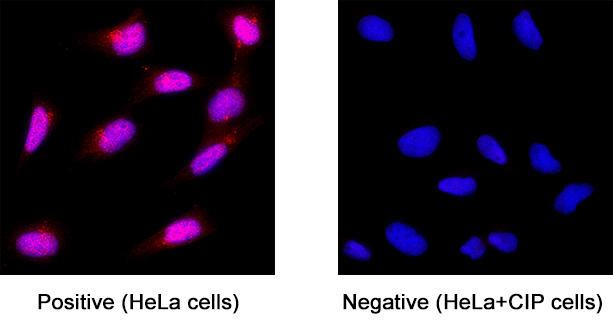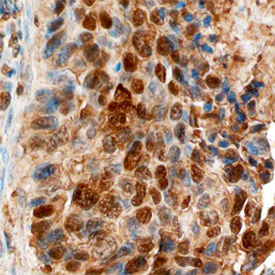Human ATM Antibody Summary
Arg2138-Arg2400
Accession # Q13315
Applications
Please Note: Optimal dilutions should be determined by each laboratory for each application. General Protocols are available in the Technical Information section on our website.
Scientific Data
 View Larger
View Larger
ATM in HeLa Human Cell Line. ATM was detected in immersion fixed HeLa human cervical epithelial carcinoma cell line (untreated; positive staining) and HeLa human cervical epithelial carcinoma cell line treated with CIP (negative staining) using Sheep Anti-Human ATM Antigen Affinity-purified Polyclonal Antibody (Catalog # AF2290) at 3 µg/mL for 3 hours at room temperature. Cells were stained using the NorthernLights™ 557-conjugated Anti-Rabbit IgG Secondary Antibody (red; NL004) and counterstained with DAPI (blue). Specific staining was localized to cell nuclei. Staining was performed using our protocol for Fluorescent ICC Staining of Non-adherent Cells.
 View Larger
View Larger
ATM in Human Breast. ATM was detected in immersion fixed paraffin-embedded sections of human breast using Sheep Anti-Human ATM Antigen Affinity-purified Polyclonal Antibody (Catalog # AF2290) at 10 µg/mL overnight at 4 °C. Before incubation with the primary antibody, tissue was subjected to heat-induced epitope retrieval using Antigen Retrieval Reagent-Basic (Catalog # CTS013). Tissue was stained using the Anti-Sheep HRP-DAB Cell & Tissue Staining Kit (brown; Catalog # CTS019) and counterstained with hematoxylin (blue). Specific staining was localized to cytoplasm and nuclei. View our protocol for Chromogenic IHC Staining of Paraffin-embedded Tissue Sections.
Reconstitution Calculator
Preparation and Storage
- 12 months from date of receipt, -20 to -70 °C as supplied.
- 1 month, 2 to 8 °C under sterile conditions after reconstitution.
- 6 months, -20 to -70 °C under sterile conditions after reconstitution.
Background: ATM
ATM (Ataxia Telangiectasia Mutated) is a 350-370 kDa member of the ATM subfamily, PI3/PI4-kinase family of enzymes. It is ubiquitously expressed, and serves as a DNA damage sensor. ATM is activated via autophosphorylation at double strand breaks. Following activation, multiple substrates are phosphorylated, including Chk2, and ATR is recruited and activated as part of an integrated repair circuit. Human ATM is 3056 amino acids (aa) in length. It contains one FAT (focal adhesion targeting) domain (aa 1960-2566), a PI-3/PI-4 kinase catalytic domain (aa 2712-2962) and a second, C-terminal FAT domain (aa 3024-3056). There are at least six Ser and four Thr utilized phosphorylation sites, and one critical acetylation activation site at Lys3016. There are at least four potential splice variants. One shows a Trp substitution for aa 536-3056, a second contains an eight aa substitution for aa 2506-3056, a third possesses a five aa substitution for aa 1637-3056, while a fourth contains a premature truncation after Lys2756. Over aa 2138-2400, human ATM shares 82% aa identity with mouse ATM.
Product Datasheets
FAQs
No product specific FAQs exist for this product, however you may
View all Antibody FAQsReviews for Human ATM Antibody
There are currently no reviews for this product. Be the first to review Human ATM Antibody and earn rewards!
Have you used Human ATM Antibody?
Submit a review and receive an Amazon gift card.
$25/€18/£15/$25CAN/¥75 Yuan/¥2500 Yen for a review with an image
$10/€7/£6/$10 CAD/¥70 Yuan/¥1110 Yen for a review without an image

